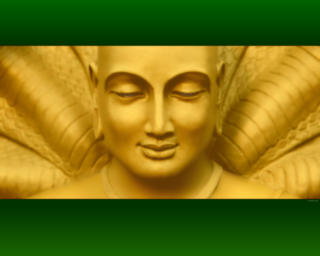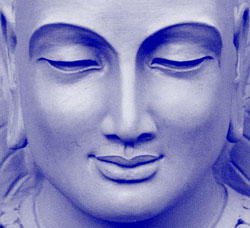Patanjali: A Shiv Bhakt
Legend has it that Aadi Seshan, the serpent (couch) of Vishnu, heard Vishnu's exhilarating description of Shiva's Dance of Bliss. Filled with irrepressable desire to witness this dance in person at Chidambaram, Seshan descended to the earth as Patanjali (the one who descended).
His name derives from Pata meaning he fell and anjali the kneeling posture with palms pressed that signifies supplication/worship.
It refers to his origins: Once, when Lord Vishnu was seated on his couch supported by Lord Adishesha (the king of all serpents,) and they were watching Lord Shiva's dance of enchantment (Skt. tandava nrtya,) Lord Vishnu became so absorbed in the movements of Lord Shiva that his body began to vibrate to the tandava rhythm. The vibration made him heavier and heaviercausing a lot of discomfort to Lord Adishesha who, nearing the point of collapse, was gasping for breath. But as soon as the dance came to end, Lord Vishnu's body once again became lighter.
Lord Adishesha was amazed at the transformation and asked his master the cause of the changes. Lord Vishnu explained about the emotional impact, the aesthetic and kinaesthetic effects that dance can have on the spectator. Marveling at this, Adishesha was then inspired to learn to dance to do honour to his lord. Lord Vishnu reflected on that aspiration, and then made the prediction that soon Lord Shiva would request of Adishesha that he write a commentary on grammar. At that time, he would also be able to devote himself to the art of dance.
Hearing this, Lord Adishesha was filled with joy and eagerly looked forward to the future grace of Lord Shiva. He meditated in order to ascertain the manner of his next incarnation, and then he had a vision of Gonika, a female ascetic adept (Skt. tapasvini, yogini) who was praying for a son to whom she could transmit her knowledge and wisdom. Now, Gonika, thinking that her life was about to end, had not yet found anyone to whom she could transmit her knowledge.
As a last resort, when her austerities had come to an end, she called upon the Sun God, who is a witness to all on earth, and prayed that he fulfill her wish. Taking a handful of water as a final offering, she closed her eyes andconcentrated on the Sun. Then, looking at her hands as she was about to offer the water, much to her surprise, she noticed a tiny snake moving in the cup of her palms. As she looked, the snake assumed human form, and prostrating to the yogini, he asked her to accept him as her son.
He is the compiler of the Yoga Sutra, a major work containing aphorisms on the practical and philosophical wisdom regarding practice of Raja yoga. ("Yoga" in traditional Hinduism involves inner contemplation, a rigorous system meditation practice, ethics, metaphysics, and devotion to the one common soul, God, or Brahman/Atman.)
Virtually nothing is known about the life of Patanjali, and some scholars believe he is entirely mythical. Various references suggest he lived between 200 BC and 400 AD. Ancient texts often refer to Patanjali as an incarnation of the serpent god Ananta, and he is sometimes depicted as half human and half serpent.
Patanjali is the reputed author of the Yoga Sutra, as well as commentary on Panini's Sanskrit grammar (aShTAdhyAyI) which is called 'mahAbhAShya'. There are also many ayurvedic texts attributed to him. Nearly all scholars believe these texts were actually written by different people in different eras.
The Yoga Sutra probably dates from around AD 200. Patanjali has often been called the founder of Yoga because of this work, although in reality is more a major figure. The Yoga Sutra is a treatise on Raja Yoga, built on Samkhya and the Hindu scripture of the Bhagavad Gita. Yoga is also found in the Puranas, Vedas and Upanishads. Still, this work is certainly a major work among the great Hindu scriptures and certainly is the basis of Raja Yoga. Patanjali's Yoga is part of the six schools of Hindu Philosophy. They give us the earliest reference to the popular term Ashtanga Yoga which translates literally as the eight limbs of yoga. They are yama, niyama, asana, pranayama, pratyahara, dharana, dhyana and samadhi.
Virtually nothing is known about the life of Patanjali, and some scholars believe he is entirely mythical. Various references suggest he lived between 200 BC and 400 AD. Ancient texts often refer to Patanjali as an incarnation of the serpent god Ananta, and he is sometimes depicted as half human and half serpent.
Patanjali is the reputed author of the Yoga Sutra, as well as commentary on Panini's Sanskrit grammar (aShTAdhyAyI) which is called 'mahAbhAShya'. There are also many ayurvedic texts attributed to him. Nearly all scholars believe these texts were actually written by different people in different eras.
The Yoga Sutra probably dates from around AD 200. Patanjali has often been called the founder of Yoga because of this work, although in reality is more a major figure. The Yoga Sutra is a treatise on Raja Yoga, built on Samkhya and the Hindu scripture of the Bhagavad Gita. Yoga is also found in the Puranas, Vedas and Upanishads. Still, this work is certainly a major work among the great Hindu scriptures and certainly is the basis of Raja Yoga. Patanjali's Yoga is part of the six schools of Hindu Philosophy. They give us the earliest reference to the popular term Ashtanga Yoga which translates literally as the eight limbs of yoga. They are yama, niyama, asana, pranayama, pratyahara, dharana, dhyana and samadhi.




No comments:
Post a Comment